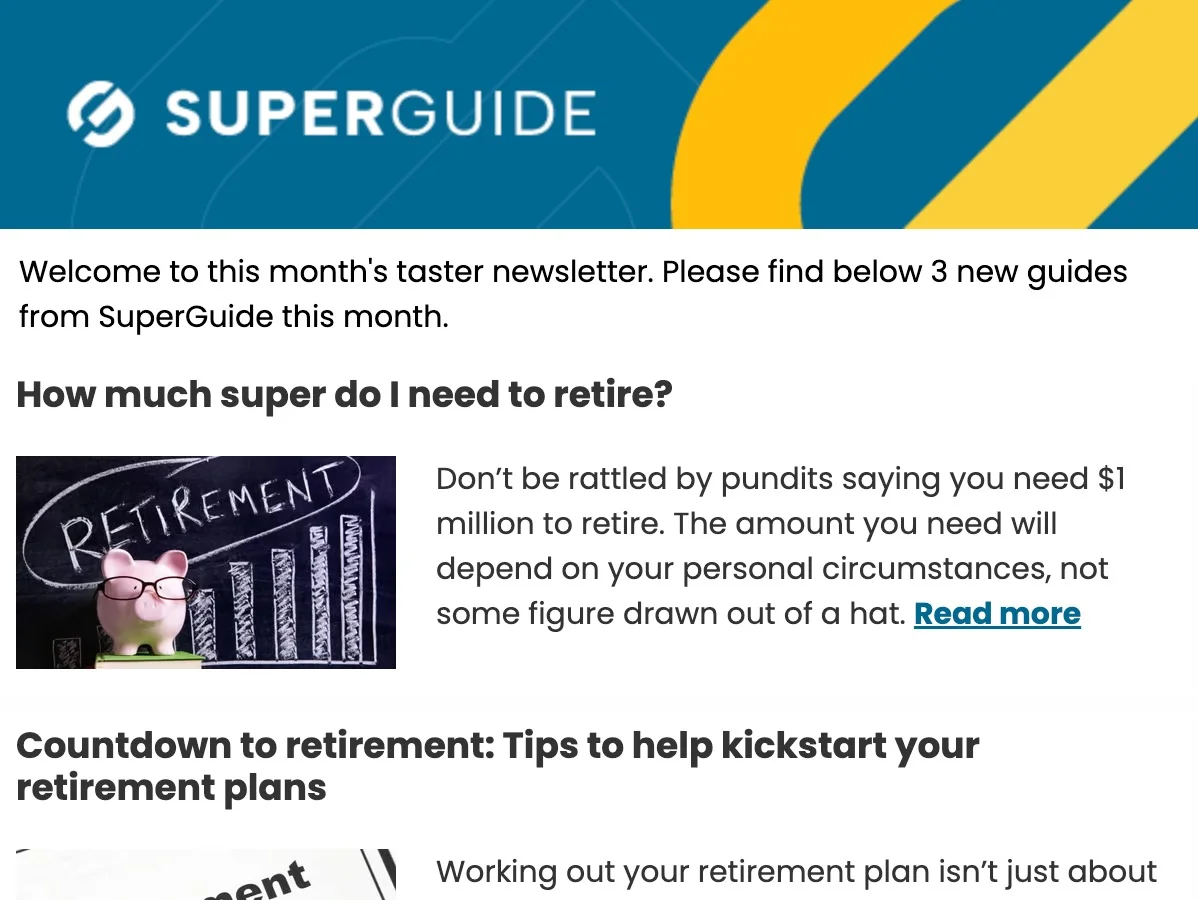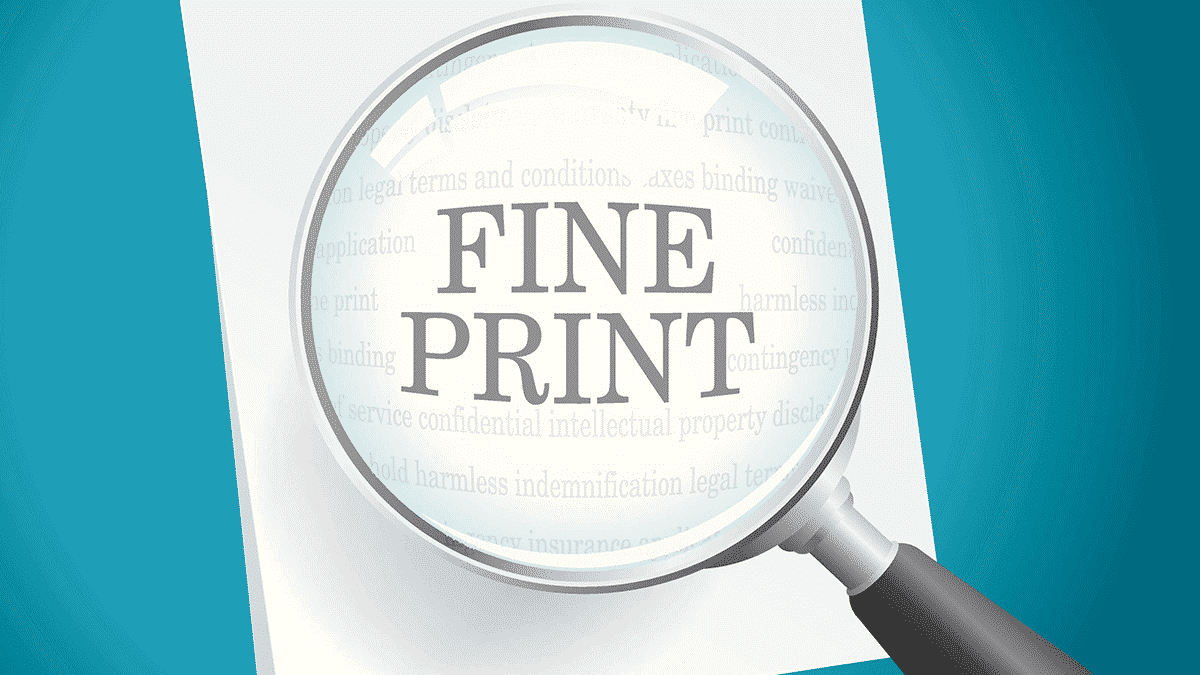In this guide
By the time you retire, chances are that superannuation will be your biggest store of wealth outside the family home. Yet we tend to spend more time researching the best mobile phone plan or our next holiday than we do on our super.
So even if you find superannuation mind-numbingly dull and difficult to understand, it matters. And when something really matters, it’s worth a few moments of your time.
Not convinced? Here’s why.
Tucked away in the Product Disclosure Statement (PDS) of every super fund is a warning that they are legally required to include.
Real consequences
It may sound like a general statement that’s easy to skip over, but it has real consequences for your retirement savings. Say you paid 2% in fees over 30 years and ended up with a retirement balance of $400,000. If you had paid 1% in fees you could have had $500,000. That’s a $100,000 difference!
Or this, from the Productivity Commission review of superannuation handed down in January 2019.

Free eBook
Retirement planning for beginners
Our easy-to-follow guide walks you through the fundamentals, giving you the confidence to start your own retirement plans.
"*" indicates required fields
It is nigh impossible to overstate the significant implications for members’ retirement incomes from (the) wide dispersion in fund performance over the long term.
Following the Productivity Commission recommendations and the government’s subsequent Your Future, Your Super reforms, funds are now subject to an annual performance test by the Australian Prudential Regulation Authority (APRA). In addition, the ATO has created a new interactive online YourSuper comparison tool. Remember this tool only compares MySuper options. If you are not in your fund’s MySuper option you’ll need to check the fees and investment returns for your chosen investment with your fund.
Both these initiatives make it easier to check how your fund compares, as well as providing insights into the long-term effects of poor performance. For example, APRA’s latest MySuper Heatmap looked at the example of a member with a $50,000 balance in June 2014. In the seven years to June 2021, their balance would have grown to $90,594 in a high-performing fund but just $79,207 in an underperforming fund. That’s $11,387 or 12.6% lower.
In 2021, 45% of MySuper products performed below APRA’s heatmap benchmarks while more than 60% of Choice investment options returned less than the benchmark. If you’re looking at joining a super fund, or simply checking whether your current fund is fit for purpose, these comparison tools are a good starting point. For more detailed information about fees and performance objectives for someone with your risk profile, you need to turn to the fund’s PDS.
So what is a PDS and where do I find it?
A Product Disclosure Statement (PDS) is a document that financial service providers must give you when they recommend or offer a financial product. “It must include information about the product’s key features, fees, commissions, benefits, risks and the complaints handling procedure,” according to MoneySmart.
You’ll find a super fund’s PDS on their home page, generally under a tag such as ‘forms and documents’. You’ll also find separate PDS documents for the fund’s accumulation, defined benefits, transition to retirement (TRR) and retirement and personal super offerings, so make sure you read the right one for your circumstances.
Alternatively, you can contact the fund to request a hard copy of the PDS.
The good news is that these PDS documents are a lot easier to read than the terms and conditions for your mobile phone plan or travel insurance. They’re not as long, for one thing. Also, they are written in plain English for the most part and follow a set formula that makes them easy to compare.
If you’re still not convinced, then here’s a cheat sheet of the sections you can’t afford not to read.
2026 SMSF calendar
Our free calendar includes due dates for important documents plus suggested dates for trustee meetings and other strategic issues for your SMSF.
"*" indicates required fields
Fees and costs
There’s no escaping fees and costs, but some funds charge higher fees and more of them than others.
Fees in a PDS document may be expressed as a dollar amount or a percentage of your account balance. Some fees may be deducted monthly, annually or when a transaction or other action takes place.
Here’s a list of the main types of fees:
- Administration fees: Cover the cost of operating the fund and keeping your super account as well as intra-fund advice.
- Investment fees: Fees for managing your investment, which can vary for different investment options.
- Indirect costs: Costs paid by your super fund to external providers that affect the value of your investment. Typically, these are costs paid to investment managers.
- Advice fees: Fees for personal advice on your super and other investments. Your adviser may also receive fees and commissions for certain investments they recommend to you and these are not included in the PDS document.
- Switching fees: Fees for changing your investment option within the fund.
- Buy/sell spread: Buy/sell spreads apply when you make transactions, including contributions, investment switches, and withdrawals. The price to buy a unit in the investment option is higher than the price you would receive for selling a unit on the same day. The difference is the ‘spread’. This spread covers the costs associated with buying and selling underlying assets.
- Insurance premiums: The cost of insurance provided through your super fund. Many super funds have a set default insurance option. You can usually choose to change your level of cover based on your needs.
- Other activity-based fees: These fees are only charged if your super fund provides you with a particular service; for example, a family law split fee where you’re charged to split your super following a separation and family law court order.
Not all funds charge all these fees, so it’s worth looking at what other funds charge for comparable investment options.
Add up how much you are paying in fees and other costs on an annual basis and convert this dollar amount into a percentage of your total balance. If it’s closer to 1% than 2% you are doing well.
If you’re in the MySuper default option, funds are now required to provide a worked example showing the total fees on a $50,000 balance. This makes it easier to compare with other funds on a like-for-like basis.
To see how fees will affect your retirement income, check out SuperGuide’s Super fees and returns calculator or the government’s MoneySmart superannuation calculator.
How is your money invested?
This section explains how your money is allocated to different assets classes such as cash, shares, bonds, property, infrastructure and private equity.
Super knowledge is a super power

"*" indicates required fields
It will also give the investment objective of your option over various time frames expressed as CPI (consumer price index, a measure of inflation) + x%. Say, for example, the objective of your fund is CPI plus 4% a year over any ten-year period. Since the introduction of compulsory super in 1992, the median growth fund has returned 8.1% per year. The annual CPI increase over the same period is 2.5%, giving a real return (above inflation) of 5.6% per year. According to Chant West, over the last 20 years the median growth fund has exceeded its return objective over most rolling ten-year periods.
Armed with this information, you can check your annual statement to see if your recent and long-term returns match the objective. You can also check your returns against those for comparable funds or other options your fund offers that may better suit your risk profile.
As well as returns, funds must explain the risk levels of their investment options using something called the Standard Risk Measure. This shows the risk rating of investment options from very low to very high. It also estimates the number of years you might expect a negative return in any 20-year period, from less than 0.5 times for cash options to 6 or greater for growth and high growth options.
Apart from giving you a better idea of the risks and returns you can expect, this section will help you compare funds and options on a like-for-like basis.
Insurance in super
It’s a rare person who knows what sort of insurance they hold in super, if any, let alone what it’s costing them, what it covers and wait times.
Your annual statement will answer some of these questions, but for more details you need to go to the PDS. This sets out the types of insurance included in default cover for those who are eligible and the annual cost of premiums.
It will also explain how to apply for top-up cover if you think you need it.
How super is taxed
The PDS pulls together information on the taxation of before-tax and after-tax super contributions, investment earnings and drawdowns before and after you turn 60.
Make your super work harder – for free

Get practical, independent guidance to help you grow your balance, save tax and make smarter super decisions with a free SuperGuide account.
Find out moreThe taxation of super is mind-boggling in its complexity, especially if you are looking at a transition-to-retirement (TTR) income stream or starting an account-based pension. The PDS will help, but it’s highly recommended you also seek professional advice.
Getting more detail
You’ll find your super fund’s PDS is a maximum of 8 A4 pages long. This makes it easier to read and digest, but it does mean that it can’t contain all the information about your fund.
The PDS outlines only the fund’s default investment option and default insurance arrangements.
If you want more detail on the fund’s investment options, you’ll need to refer to the separate investment guide. This will explain all the options available, their risks and asset allocations, and the associated fees.
Similarly, if you want more detail on insurance cover, you’ll need to look at the insurance guide. This document explains the insurance on offer in much more detail, including the cost of additional cover, eligibility rules, how much you can apply for, when cover starts and stops and limitations or exclusions.
Insurance and investment guides are ‘incorporated by reference’ into the short PDS. They are separate documents, but technically form part of the PDS. To get the whole picture on what your fund offers, you need to read them. You should be able to find these guides easily on your fund’s website in the investment and insurance sections or with the PDS itself.
Reading your super fund’s PDS may not be your idea of a fun time, but it will be worth it when you retire and start ticking off your bucket list. You may be surprised by what you learn.



Leave a Reply
You must be logged in to post a comment.